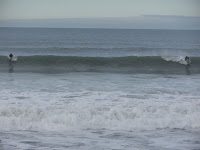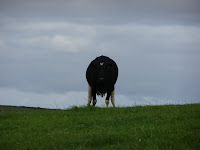Sunday 1st November
Walk distance 9km
Cycle 0km
Height 200m est
4 hours
1km walk to Westdale from Dale.
Total coastal distance walked 8 km
Total coastal distance cycled 0
Running coastal total distance 269.45km
Running height climbed 8311m
I parked in Dale at 8AM and walked back across
the peninsula to Westdale, along a u shaped valley carved out by a glacier.
Still early, the dawn light made the red rocks of the cliffs glow. The
walk towards the light house was pleasant and easy. Surprisingly for November
1st it was warm, the sky blue and the air still. I passed the broken rubble
remains of World War two buildings and defences. These included a Navy meteorological
and radar centre.
The whole peninsula was militarised to protect Millford Haven.
It is a shame so many buildings have been demolished. As I walked I detected a strange noise in the
distance. At first I thought it might be the noise of the wire on a distant
flagpole. But as I approached the point
where the lighthouse was I realised the intermittent noise was a fog horn. Aimed out to sea it wasn’t too loud on the
cliffs. After being silent for one
minute, two bursts would warn passing ships.
There were ships on the move too and out to sea there was indeed
fog. I drank coffee on a high vantage
point before carrying on to the lighthouses.
There were two lighthouse, one a disused and
now a private property, for sale at £975,000.
The other still working, adjacent to a row of empty admiralty houses. St. Ann’s head was the scene of an accident
when the tanker, Sea Empress, spilled 72000 tonnes of crude oil in 1996. Rounding the point was rewarding and quickly
lead to a very famous bay in English history.
Mill Bay is where Henry Tudor and 2000 men landed in 1485. From here he marched to Bosworth Field and
defeated the Lancastrian king.
Further
on I reached West Blockhouse Fort, built to defend Milford Haven, and lovingly
restored by the Landmark Trust. Here I
saw, and raced, my first oil tanker, racing to the fort to get a good
photo. All morning it had been getting
warmer and I was keen to drop down to Watwick Bay to paddle and have
lunch.
With no wind the beach was
incredibly warm. With the tide going out
the current felt too strong to risk swimming, but it was good to paddle. After relaxing in the suns, and after an
enjoyable lunch, the third three days running of oat cakes, cheese, apple,
followed by coffee and chocolate I carried on. The path led up through scrub to
another point where a huge tower, 50 meters high, at Watwick point guides
modern shipping. As I passed it an Irish ferry went by. Only now did I start to
pass other people walking in the opposite direction. I saw my first birds of prey of the weekend,
both a kestrel and buzzard.
Today I saw
even more flower out, including knapweed and daisies. The walk then bypasses Dale Fort. This is part of the Field studies
council. Many years ago I came on a
field trip here, which I enjoyed thoroughly.
We spent much time studying the coastline and plants and animals living
in the different habitats. I particularly remember looking at plants on sand
dunes and identifying different types of barnacle. In fact one of the lecturers was an inspiration
to my later career in conservation. Thank you. The last part of the walk was
through shady woodland along a tarmac road down to Dale and to the car park
where I started. At my car, my temperature gauge read 19 degrees Celsius.
Strangely on my return journey, via Brecon, the weather transformed. At Brecon
it was 10 degrees and thick fog.



























































